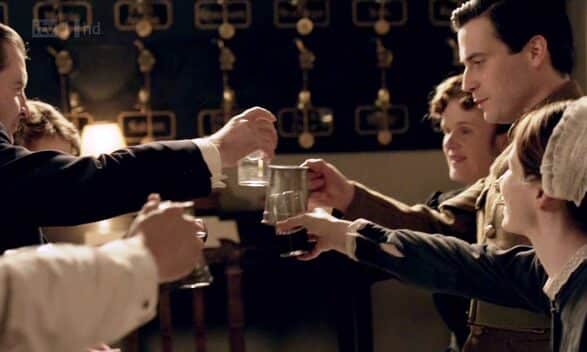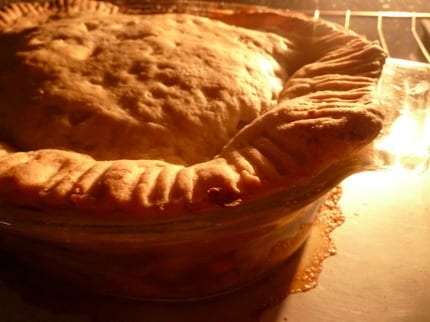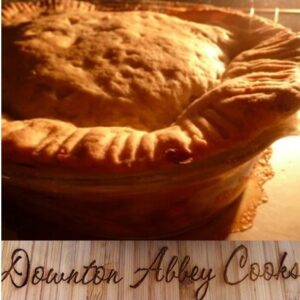Downton Abbey fans were thrilled with the news in S2E6 that the Great War was over, particularly after the previous sombre episode where Matthew and William come home wounded from the war, and William succumbs to his injuries. Bummer. At long last we will be able to return to new fashions, extravagent dinners, turkey shoots, garden parties, and other gaity that goes on in the life of the privileged, and those so happy to be in service to them. Life does go on, but alas, not in the way that anyone had hoped. This is a telling scene from the opening of Episode 7 which sets the tone of life in post war Europe.
[youtube http://www.youtube.com/watch?v=P9OqPpfgWFk&w=560&h=315]
To recap, in the words of the pessimists: “Welcome to the new world”, and all is not rosey. “When war is over, the first emotion is relief. The second disappointment.” “How sad. How True.” This is countered by the wise words of Mrs. Patmore: “The Lord tempers the wind to the shorn lamb”, which actually doesn’t come from the Bible, but nonetheless was a phrase originated in 18th century that means that God mercifully ensures that misfortune does not overwhelm the weak or helpless. Hope floats.
The Trials of Troubled Thomas
While we would never wish harm to anyone, I admit to taking some delight in watching Thomas squirm as he tries to find his way in this new world. This is a fellow who should have been in a demolitions unit in the war, as he is quite skilled at burning bridges; then again he isn’t the brightest spark in the box.
He made enemies of Mr. Carson and Lord Grantham when he was caught thieving. He escapes dismissal by volunteering for the medical corps, hoping to land a cushy medical assignment. Unfortunately he winds up at the front. Thanks to the remarkable marksmanship of an obliging German soldier, he returns home, and with the help of O’Brien, manages to find himself in charge of Downton Abbey’s convalescing operations. Snubbing his nose at his former employers and servants at every turn, he did get a great idea from our heroine, Mrs. Patmore, who spent alot of time fetting about food shortages. He is duped by a black market dealer (horrors) for supplies to set up his own black market business, and is left without money, a place to stay, or a job. Now scrambling to find a place for himself back at Downton. Mrs. Patmore observes “it is wonderful what fear will do for the human spirit.” Don’t worry, he eventually lands on his feet, getting back into the good graces of Lord Grantham in the Christmas episode. But in the meantime, yes, it is time for Thomas to have a nice big helping of humble pie.
Eating Humble Pie
To “eat humble pie” is an idiom which originated in the UK, meaning to “act submissively and apologetically, especially in admitting an error.” Its origins relate to the umble pie. In the 15th century the name for the entrails of a deer were called umbles, and eventually migrated to the term humble. Umbles were used as an ingredient in pies. The adjective “humble”, meaning ‘of lowly rank’ or ‘having a low estimate of oneself’, was derived separately from umbles. The similarity of the sound of the words, and the fact that umble pie was often eaten by those of humble situation (the best cuts of meats went to the wealthy) could easily have been the reason for the phrase to ‘eat humble pie’ to have its current meaning.
Hmm, deer entrails. Yes, a nice big piece of humble pie would certainly be a fitting dish for Thomas. Having said that Haggis–which is made of sheep entrails (so much for the shorn lamb–is prized the Scots and me, so who’s to say if it would be edible. Check out an original recipe and decide for yourself.
(H)umble Pie Recipe, 1591
Mince them very small with Suet, and season them with Pepper, a little Ginger, a little Sinamon and Corance, and out into your paste, and when your pye is baked, put to it two spoonfuls of Claret wine, and shake it well togither.
Vegetable Pie with Potato Crust
I dare say that any part of a deer would have been prized during the rationing. The woods likely would have been picked/poached clean. Quite often cooks had to create dishes from the vegetables they would have had on hand.
This is a lovely adaptation of one of those original war-time recipes of a savoury meatless pie using what ingredients which would have been on hand. I have never attempted to grow an artichoke (It is enough just to core them), but they are quite hearty and like cool English climes. Even Mrs. Beeton had them on her favorite veggie list.
Vegetable Pie with Potato Crust
Ingredients
Filling
- 2 large onions
- 2 large carrots
- 3 stalks celery
- 1 medium turnip
- 2 cups low sodium vegetable stock
- 1 cup lentils canned
- 1 pinch salt and pepper
- 1 pinch herbs and spices (rosemary, cumin) to taste
Pastry
- 1 medium potato mashed
- 1 1/3 cups unbleached flour
- 1/4 cup shortening
- 1 tsp. baking powder
- 1 dash salt
Instructions
- Preheat oven to 375º F
- Scrub and then finely chop all vegetables. Leave the skins on for extra nutrients. Sauté with herbs in olive oil until soft.
- Take off heat and add vegetable stock and the lentils.
- Spoon the filling into a casserole dish (will yield too much filling for a pie plate)
Make the Pastry
- To make the pastry mix the shortening into the dry ingredients
- Add the mashed potato, mixing together with a little cold water. It should make a nice easy-to-roll dough.
- Roll out the pastry and cover, sealing the edges of the pie with a fork.
- Bake for 45 minutes and serve hot.
Notes
Vegetable Pie with Potato Crust
Ingredients
Filling
- 2 large onions
- 2 large carrots
- 3 stalks celery
- 1 medium turnip
- 2 cups low sodium vegetable stock
- 1 cup lentils canned
- 1 pinch salt and pepper
- 1 pinch herbs and spices (rosemary, cumin) to taste
Pastry
- 1 medium potato mashed
- 1 1/3 cups unbleached flour
- 1/4 cup shortening
- 1 tsp. baking powder
- 1 dash salt
Instructions
- Preheat oven to 375º F
- Scrub and then finely chop all vegetables. Leave the skins on for extra nutrients. Sauté with herbs in olive oil until soft.
- Take off heat and add vegetable stock and the lentils.
- Spoon the filling into a casserole dish (will yield too much filling for a pie plate)
Make the Pastry
- To make the pastry mix the shortening into the dry ingredients
- Add the mashed potato, mixing together with a little cold water. It should make a nice easy-to-roll dough.
- Roll out the pastry and cover, sealing the edges of the pie with a fork.
- Bake for 45 minutes and serve hot.



